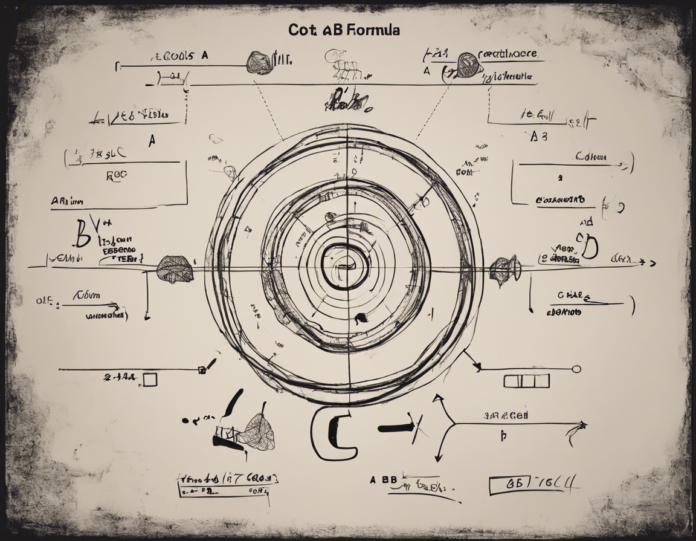Trigonometry is a branch of mathematics that deals with the relationship between the angles and sides of triangles. One of the fundamental topics within trigonometry is trigonometric identities, which are mathematical equations involving trigonometric functions that are true for all possible values of the variables involved. In this blog post, we will delve into one specific trigonometric identity known as the cotangent of the sum identity. We will explore what this identity entails, how it is derived, and how it can be used in various mathematical calculations.
Understanding the Cotangent of the Sum Identity
The cotangent of the sum identity relates the cotangent of the sum of two angles to the cotangents and tangents of the individual angles. The identity is expressed as follows:
cot(A + B) = (cot A * cot B – 1) / (cot A + cot B)
In this equation, A and B are the two angles whose cotangents are being considered. The cotangent of the sum of two angles can be expressed in terms of the cotangents and tangents of the individual angles involved.
Deriving the Cotangent of the Sum Identity
To derive the cotangent of the sum identity, we start with the trigonometric definition of cotangent. The cotangent of an angle is defined as the ratio of the cosine of the angle to the sine of the angle. Therefore, we have:
cot A = cos A / sin A
cot B = cos B / sin B
Next, we consider the sum of angles A and B and apply the trigonometric identities for the sum of angles:
cos(A + B) = cos A * cos B – sin A * sin B
sin(A + B) = sin A * cos B + cos A * sin B
Dividing the expression for cos(A + B) by sin(A + B), we get:
(cos A * cos B – sin A * sin B) / (sin A * cos B + cos A * sin B)
This expression can be simplified further to obtain the cotangent of the sum identity:
cot(A + B) = (cot A * cot B – 1) / (cot A + cot B)
Applications of the Cotangent of the Sum Identity
The cotangent of the sum identity has various applications in mathematics, physics, engineering, and other fields. Some common applications include:
-
Trigonometric Calculations: The identity can be used to simplify trigonometric expressions involving the cotangent function.
-
Signal Processing: In signal processing, the cotangent of the sum identity can be utilized in analyzing and processing signals.
-
Mechanical Engineering: The identity can be applied in mechanical engineering calculations involving angles and rotations.
-
Navigation: In navigation systems, the cotangent of the sum identity can be used in determining positions and directions.
Practical Example
Let’s consider a practical example to illustrate the application of the cotangent of the sum identity. Suppose we have A = 30 degrees and B = 45 degrees. We can apply the identity to find cot(30 + 45) as follows:
cot(30 + 45) = (cot 30 * cot 45 – 1) / (cot 30 + cot 45)
Substitute the values of cot 30 and cot 45:
cot(30 + 45) = ((sqrt(3)/3 * 1 – 1) / (sqrt(3)/3 + 1)
After simplification, we find the cotangent of the sum to be a specific numerical value.
Frequently Asked Questions (FAQs)
-
What is the cotangent function?
The cotangent function, denoted as cot, is the reciprocal of the tangent function. It is defined as the ratio of the cosine of an angle to the sine of the same angle. -
What is the sum of angles identity in trigonometry?
The sum of angles identity in trigonometry provides relationships between the trigonometric functions of the sum of two angles and the functions of the individual angles. -
How is the cotangent of the sum identity derived?
The cotangent of the sum identity can be derived by utilizing the fundamental trigonometric definitions and identities for cosine, sine, and cotangent functions. -
What are some practical applications of the cotangent of the sum identity?
The identity finds applications in various fields such as mathematics, physics, engineering, and navigation for simplifying calculations and analyzing relationships between angles. -
Can the cotangent of the sum identity be used for solving real-world problems?
Yes, the identity can be used to solve real-world problems involving angles, rotations, signals, and other applications where trigonometric functions are relevant.
In conclusion, the cotangent of the sum identity is a significant trigonometric identity that provides a relationship between the cotangents and tangents of angles. Understanding this identity and its applications can enhance problem-solving skills and mathematical proficiency in various disciplines.









